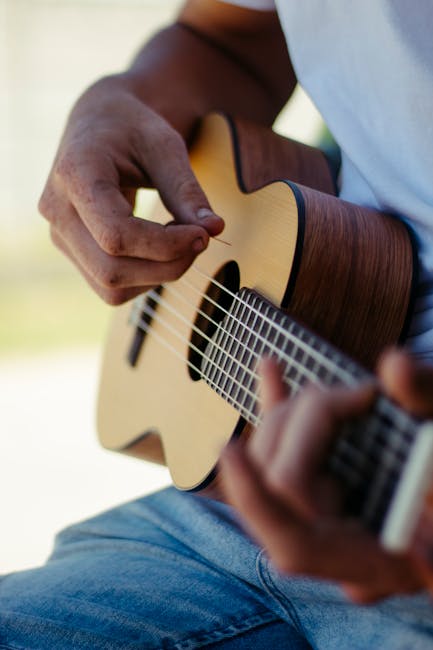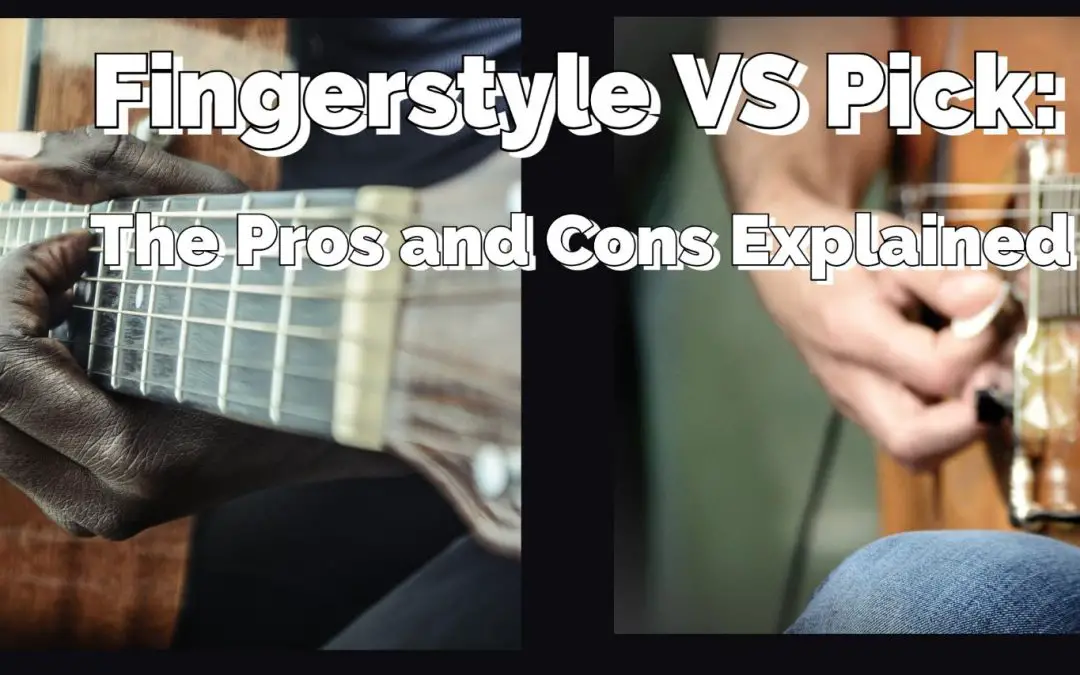In a world full of strummers and pickers, there lies a secret society of musicians who have mastered the art of fingerstyle guitar playing. These elusive creatures can effortlessly harmonize melodies with chords, creating a symphony of sound that can make even the most skilled air guitarist hang up their invisible instrument in shame. So, dust off your fingertips and prepare to embark on a journey to the land of harmonious harmony, as we uncover the secrets to mastering fingerstyle guitar playing like never before. Guitar the Best Instrument? Allow Me to Enlighten You”>Fingerstyle Guitar”>
Guitar the Best Instrument? Allow Me to Enlighten You”>Fingerstyle Guitar”>
Contents
- 1 Understanding the Fundamentals of Fingerstyle Guitar
- 2 The Art of Harmonizing Melodies in Fingerstyle
- 3 Choosing the Right Chords to Complement Your Melody
- 4 Techniques for Seamlessly Integrating Melodies and Chords
- 5 Advanced Concepts: Counterpoint and Voice Leading in Fingerstyle
- 6 Exploring Diverse Musical Genres through Fingerstyle Harmonization
- 7 Implementing Dynamics and Expression in Your Fingerstyle Arrangements
- 8 FAQs
- 9 Time to pluck your way to fingerstyle mastery!
Understanding the Fundamentals of Fingerstyle Guitar
So you’ve decided to dive into the world of fingerstyle guitar, huh? Prepare yourself for a journey filled with finger acrobatics, melodic melodies, and possibly a few calluses along the way. But fear not, for with a solid understanding of the fundamentals, you’ll be well on your way to becoming a fingerstyle maestro.
First things first, let’s talk about fingerpicking patterns. These intricate patterns are the bread and butter of fingerstyle guitar playing. Experiment with different patterns like the Travis picking technique or the alternating bass pattern to add some spice to your playing.
Next up, let’s chat about finger positioning. Your fingers are like little ninjas dancing across the strings, so it’s crucial to have proper finger positioning for maximum efficiency. Keep your fingers curved and close to the strings to ensure clean and precise notes.
Lastly, don’t forget about dynamics. Fingerstyle guitar is all about creating depth and emotion through your playing. Experiment with different dynamics like crescendos and decrescendos to add some flair to your music. Remember, the beauty of fingerstyle guitar lies in the subtle nuances.
 Harmonizing Melodies in Fingerstyle”>
Harmonizing Melodies in Fingerstyle”>
The Art of Harmonizing Melodies in Fingerstyle
Now that you’ve mastered the basics of fingerstyle guitar, it’s time to delve into the world of harmonizing melodies. This is where things start to get interesting!
One trick to creating harmonies is to play the melody with your thumb and add harmonizing notes with your fingers. It’s like juggling multiple balls at once, but with music – way cooler! Plus, it’s a great way to show off your multitasking skills.
Another fun technique is to experiment with different chord inversions to create rich, complex harmonies. Who knew that playing around with different finger positions could lead to such beautiful sounds? It’s like a puzzle for your fingers!
And let’s not forget about dynamics – playing some parts louder and others softer can really help bring out the harmonies in your melodies. It’s all about finding that perfect balance and making your guitar sing like never before. So go ahead, unleash your inner musical genius and harmonize away!
Choosing the Right Chords to Complement Your Melody
So, you’ve got a killer melody that’s catchy as heck, but what’s missing? That’s right – chords! can take your song from good to great. It’s like finding the perfect pair of shoes to go with your outfit – you wouldn’t wear flip-flops with a ball gown, would you?
When selecting chords, think about the emotion you want to convey. Are you going for a happy, upbeat vibe? Try using major chords. Want to add a touch of drama and tension? Minor chords are your best friend. Mix and match these bad boys like a mad scientist in a lab until you find the right combination that makes your melody sing.
Don’t be afraid to experiment with different voicings and inversions to spice things up. Sometimes a simple triad just won’t cut it. And remember, the rhythm of your chords is just as important as the notes themselves. Syncopation can add an extra layer of groove to your tune and keep your listeners on their toes.
So, next time you’re struggling to find the right chords for your melody, just remember – it’s all about balance, emotion, and a sprinkle of musical magic. Trust your gut, play around with different options, and before you know it, you’ll have a hit on your hands!

Techniques for Seamlessly Integrating Melodies and Chords
So you’ve got a killer melody and some sweet chords, but how do you bring them together in perfect harmony? Fear not, we’ve got some techniques that will have your melodies and chords besties in no time.
First things first, **try playing your melody and chords at the same time**. Not as easy as it sounds, huh? But once you get the hang of it, you’ll be amazed at how seamlessly they blend together. It’s like peanut butter and jelly, but with way more musical talent.
Next, **experiment with inversions**. Who said chords had to be played in the same boring order all the time? Mix it up by flipping those chords upside down and inside out. Your melodies will thank you for the fresh perspective.
And last but not least, **don’t be afraid to break the rules**. Sometimes the most magical musical moments happen when you throw tradition out the window and just go with your gut. So go ahead, be bold, be daring, and watch as your melodies and chords become the ultimate power couple.

Advanced Concepts: Counterpoint and Voice Leading in Fingerstyle
So, you think you’re a fingerstyle master, huh? Well, get ready to take your skills to the next level with the advanced concepts of counterpoint and voice leading. These techniques will make your fingers dance across the fretboard like never before, creating harmonies and melodies that will make your listeners swoon.
- Counterpoint: Forget just plucking away at the strings in a linear fashion. With counterpoint, you’ll be weaving multiple melodies together, creating a rich tapestry of sound that will have your audience wondering how many fingers you actually have.
- Voice Leading: No more random finger movements here – voice leading is all about making sure each note flows smoothly into the next. It’s like playing a musical game of connect-the-dots, except the dots are musical notes and the end result is a masterpiece.
Once you’ve mastered these advanced concepts, you’ll be able to create fingerstyle arrangements that rival even the greatest guitarists of all time. So, grab your guitar, stretch out those fingers, and get ready to take your fingerstyle game to new heights!
Exploring Diverse Musical Genres through Fingerstyle Harmonization
Who knew that harmonizing different musical genres through fingerstyle guitar could be so much fun? From blending country twang with smooth jazz to mixing rock riffs with classical melodies, the possibilities are endless. With just a few plucks of the strings, you can transport your listeners on a musical journey they never knew they needed.
Picture this: you start off with a bluesy riff that gradually transitions into a latin-inspired groove. The audience’s heads start bopping along unconsciously, caught in the spell of your harmonious fusion. Suddenly, you throw in a bit of reggae flair, and before you know it, everyone is swaying to the rhythm, lost in the sea of diverse harmonies.
Don’t be afraid to think outside the box when exploring different genres. Mix and match styles that seem completely opposite at first glance – a little bit of heavy metal with a sprinkle of folk, perhaps? Embrace the unexpected and let your fingers do the talking as you create a magical tapestry of sound that is uniquely yours.
Implementing Dynamics and Expression in Your Fingerstyle Arrangements
So you’ve mastered the basics of fingerstyle guitar playing, but now you’re ready to take your arrangements to the next level by incorporating dynamics and expression. Fear not, my fellow fingerpicker, for I have some tips to help you bring your playing to life!
Firstly, start by experimenting with your picking hand technique. Remember, the key to adding dynamics and expression lies in how you pluck those strings! Try varying the angle of your fingers when striking the strings to create different tones. Use your thumb for a warm, mellow sound, and your index finger for a brighter, more percussive tone. Don’t be afraid to get a little aggressive with your picking – a bit of controlled aggression can go a long way in adding emotion to your performance.
Next, don’t forget about your fretting hand! Use vibrato to add some flair to your notes - a little shake here and there can really make your melodies sing. Experiment with hammer-ons and pull-offs to add some extra texture to your playing. And remember, don’t be afraid to slide around the fretboard like a ninja on speed – sliding into a note can add a cool, swooping effect that is sure to impress your audience.
Lastly, don’t underestimate the power of silence. The spaces between notes are just as important as the notes themselves. Use rests strategically to build tension and create moments of anticipation. And don’t be afraid to let a note ring out and fade away into nothingness – sometimes the absence of sound can speak volumes.
FAQs
Why is fingerstyle guitar playing so popular?
Fingerstyle guitar playing is popular because it allows you to create a full, rich sound on your own without the need for a band or accompaniment. Plus, it looks super impressive to all your friends!
What are some tips for mastering fingerstyle guitar?
Some tips for mastering fingerstyle guitar include practicing regularly, learning proper hand positioning, and starting with simple songs before moving onto more complex pieces. And of course, don’t forget to have fun while doing it!
How do I harmonize melodies with chords in fingerstyle guitar playing?
Harmonizing melodies with chords in fingerstyle guitar playing involves figuring out which chords fit with the melody notes you’re playing and then incorporating them into your fingerpicking patterns. It may take some trial and error, but don’t give up!
Can I use fingerstyle techniques in different music genres?
Absolutely! Fingerstyle techniques can be applied to a wide range of music genres, from folk to blues to even rock. Experiment with different styles and see what works best for you!
How can I improve my fingerstyle guitar playing speed?
To improve your fingerstyle guitar playing speed, start by practicing slowly and gradually increase your speed over time. Focus on precision and accuracy before trying to play faster, and remember that practice makes perfect!
Time to pluck your way to fingerstyle mastery!
Congratulations on making it to the end of our guide on harmonizing melodies with chords using fingerstyle technique. You’ve learned how to pluck like a pro, strum like a champ, and make your guitar sing like never before.
Now go forth, armed with your newfound knowledge, and serenade your friends, family, and even your pet goldfish with your beautiful fingerstyle harmonies. Remember, practice makes perfect, so don’t be afraid to keep plucking until your fingers feel like they’re about to fall off.
And who knows, maybe one day you’ll be the next fingerstyle guitar virtuoso, playing to sold-out crowds and winning Grammy awards. Just remember to thank us in your acceptance speech.
Keep strumming and stay harmonious, fingerstyle rockstar!



